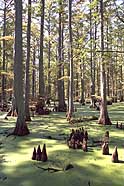
 |
Swamps
are permanent or semi-permanent bodies of water dominated by woody plants.
In Illinois, there are two types of swamp: shrub swamp and true swamp.
Shrub
Swamps
|
True
swamps
True
swamps in Illinois are dominated by bald cypress (Taxodium
distichum) and/or tupelo gum trees (Nyssa
aquatica) and are restricted in their distribution to the southern
portion of the state. Heron Pond (pictured at the top of the page) is a
bald cypress swamp along the Lower Cache River in southern Illinois. It
consists of almost exclusively bald cypress trees.
Other swamps in the area consist of almost pure stands of tupelo gum (panorama). Whereas these swamps have a characteristic series of associated shrubs such as buttonbush (Cephalanthus occidentalis), Virginia willow (Itea virginica), and swamp rose (Rosa palustris), they are dominated by trees.
The shrubs, such as Virginia willow and swamp rose, both of which are not adapted to growing in the water, often grow on bald cypress knees. Vines such as Virginia creeper (Parthenocissus quinquefolia) and poison ivy (Toxicodendron radicans) are also present in the swamp, growing in the trees and on knees where they avoid the flooded conditions.
The surface of the water is frequently hidden by a mat of bright green duckweed (Lemna sp.). The forested margins of the swamp commonly include Drummond's red maple (Acer rubrum var. drummondii), red elm (Ulmus rubra), pumpkin ash (Fraxinus profunda), overcup oak (Quercus lyrata), and swamp white oak (Quercus bicolor).
Swamps often develop in old oxbows or sloughs, which are the flooded areas in old channels along rivers or streams.
Bald
Cypress trees
Well-established
bald cypress trees can tolerate being submerged under water but the seedlings
are killed by total submergence in water. The trees must therefore become
established during periods when the soil surface is not covered with water,
during drought, for example.
The seeds germinate and become established under non-flooded conditions, perhaps along with other plants. Once established, they are better able to survive the flooding than less tolerant plants. The result is the establishment of almost pure stands of bald cypress.
Bald cypress trees can live to be one thousand years old or more. The shallow and widely spreading roots and knees and the interlocking root systems of these trees make them more stable. Similarly, the trunks of tupelo gum trees are 'buttressed', providing additional support to the root system in an unstable environment.
Swamp
as animal habitat
Swamps
provide valuable habitat for a number or birds. Cypress trees attract fish-eating
birds such as the great blue heron, black-crowned night heron, green heron,
bitterns, kingfishers, and migrating ospreys. These birds nest and perch
in bald cypress trees and knees. Wood ducks nest in the trunks of hollow
trees and species of warblers frequent the swamp during migration.
Bats frequent the swamp at dusk, flying over the surface of the water in search of insects. Numerous amphibians and reptiles are present, including the green tree frog, bird-voiced tree frog, and cottonmouth snake. The water contains fish (such as sunfish and minnows) and frogs.
|
|
Copyright © 2000 Illinois State Museum